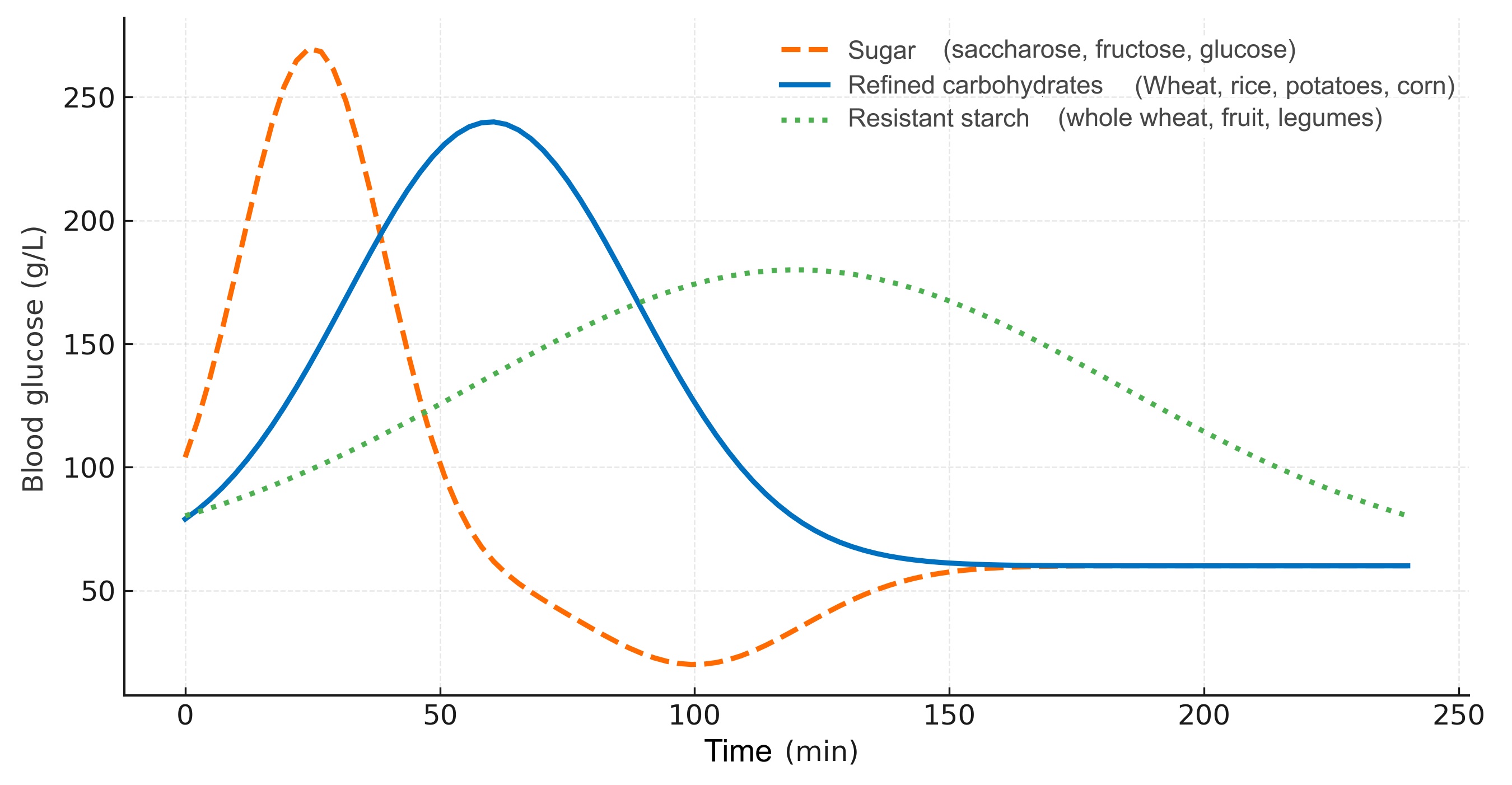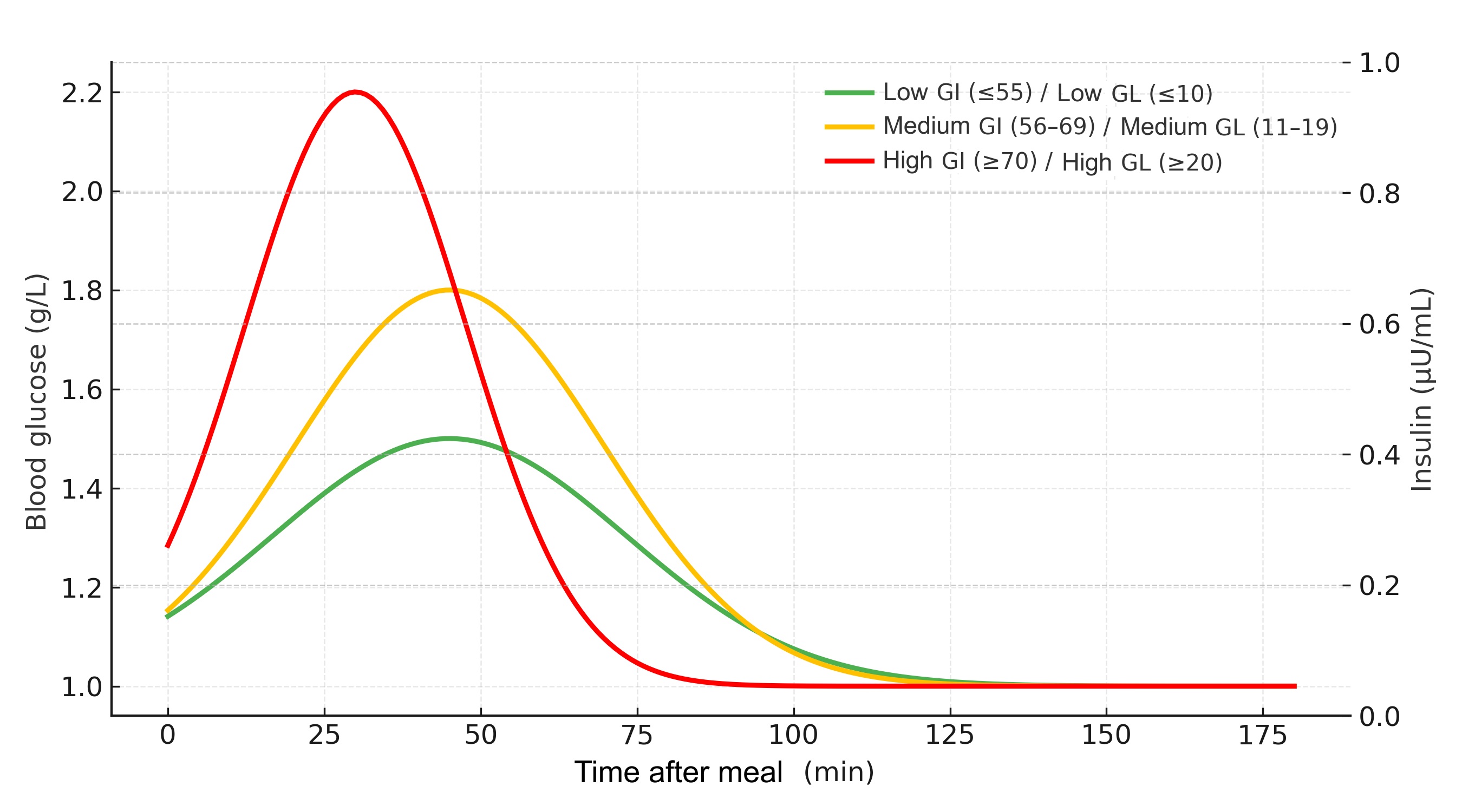Intro
The glycemic index (GI) and glycemic load (GL) describe how carbohydrate intake affects blood glucose and insulin levels. For football players and their performance teams, understanding these parameters is central to optimizing energy, performance, and recovery.
This blog post compiles the evidence behind low- and high-GI meals in relation to football, with a particular focus on timing and practical implementation.
What Do GI and GL Mean in a Football Context?
The GI ranks carbohydrate-containing foods according to how quickly they raise blood glucose compared to a reference (typically glucose). The GL, on the other hand, accounts for both the GI and the amount of carbohydrate in a given portion, providing a more realistic picture of the overall glycemic response.1
In practice, this means that a banana (moderate to high GI, moderate GL) may provide a different energy profile than white rice or high-GI energy bars, even if they contain the same amount of carbohydrate. This has implications for the timing of meals before, during, and after training or competition.
Physiological Background
During football, repeated bouts of high-intensity activity rely primarily on muscle glycogen as the main fuel.2 When glycogen stores are depleted, performance declines—particularly during decisive phases of the match.3 Therefore, nutrition strategies that help preserve or optimize glycogen utilization are of particular importance.
A low-GI meal before a match can theoretically reduce the rapid insulin spike and enhance fat oxidation, potentially sparing muscle glycogen.4 Conversely, a high-GI meal is beneficial after a match, where rapid glycogen replenishment is desired.5
Before Physical Performance
Low-GI Pre-Exercise Meals
Several studies have shown that consuming a low-GI meal 2–3 hours before training or a match can result in lower carbohydrate oxidation during exercise and more stable blood glucose.6,7 This may lead to higher fat oxidation and thus a glycogen-sparing effect, potentially improving performance in the later stages of the game.8
A study on recreational football players found that low-GI sports nutrition bars improved sprint performance and reduced RER (respiratory exchange ratio), indicating increased fat utilization.9 Other studies have reported similar tendencies for agility and jump height when low-GI foods were consumed pre-exercise.10
High-GI Pre-Exercise Meals
However, studies where both low- and high-GI meals were consumed 30–45 minutes before activity found no significant differences in performance.11 This suggests that timing is critical: a low-GI meal should be consumed 2–3 hours before activity, whereas a high-GI meal closer to kickoff does not necessarily impair performance.
Rebound hypoglycemia, which could theoretically occur with high-GI intake shortly before exercise, is rarely seen in football players—likely due to increased catecholamine release during high-intensity activity, which blunts insulin’s effect.12

Glycemic response — different carbohydrate sources: illustrating how various carbohydrate types affect blood glucose over time after ingestion.
Simple sugars (e.g., glucose, fructose, sucrose) cause a rapid and steep rise in blood glucose, followed by a fast decline—a classic high-glycemic response. Refined starches (rice, wheat, potato) create a moderate and more prolonged rise, while resistant starches from whole grains, legumes, and fruit provide a lower and more stable curve.
For football players, this means that carbohydrate choice before a match affects energy availability throughout play. Low-GI foods provide a steadier energy supply, while high-GI foods provide quick energy but may lead to faster drops in blood glucose if consumed too early.
The glycemic load (GL) considers both the quantity and quality of carbohydrates in a meal, giving a more practical reflection of how a meal collectively influences blood glucose.
During Physical Performance
During matches and high-intensity training, carbohydrate intake in liquid or gel form (typically high GI) helps maintain blood glucose and delay glycogen depletion. An intake of 30–60 g of carbohydrate per hour has been shown to improve performance during prolonged intermittent sports such as football.13
A study on elite female football players demonstrated improved repeated sprint ability when athletes consumed a high-carbohydrate, low-GI drink during match play compared to a control condition.14 The combination of fluid and carbohydrate provides both hydration and energy benefits.
After Physical Performance (Recovery)
Post-exercise, rapid glycogen resynthesis is essential for optimal recovery—especially in congested training and match schedules. High-GI meals increase insulin response and accelerate glycogen synthesis, making them particularly beneficial post-exercise.15
A general guideline is to consume approximately 1 g of carbohydrate per kg body weight per hour during the first 3–4 hours after exercise, combined with 0.25–0.5 g of protein per kg.16 This supports both glycogen replenishment and muscle repair.

Relationship between GI, GL, blood glucose, and insulin: demonstrating how glycemic index and load influence both blood glucose and insulin responses.
A high-GI/GL meal (red curve) produces a sharp increase in both blood glucose and insulin, which can be advantageous post-match or training when rapid glycogen restoration is desired. A low-GI/GL meal (green curve) yields a more moderate and stable glucose profile, ideal before matches when a steady energy supply is preferred without major insulin fluctuations.
The insulin response (right axis) mirrors the glucose pattern, illustrating why GI and GL are key parameters in matchday nutrition planning.
Practical Takeaways
| Timing | GI Recommendation | Purpose | Example Foods |
|---|---|---|---|
| 2–3 hours before match/training | Low-GI | Stable energy and fat oxidation | Oatmeal, lentils, whole-grain bread |
| 30–60 min before match | Moderate to high-GI | Rapidly available energy | Banana, white bread with honey |
| During match/training | High-GI | Maintain blood glucose and performance | Sports drink or gel |
| After match/training | High-GI | Glycogen replenishment and recovery | Rice, mashed potatoes, sports drink + protein |
Implementation in CarboPlanner
CarboPlanner applies glycemic index (GI) and glycemic load (GL) principles directly within its planning logic. Each food in the database is tagged with a precise GI value, and the platform automatically calculates the total GL for every meal. The algorithm continuously adapts meal recommendations based on training intensity, timing, and athlete goals, predicting when each meal’s glycemic load should peak to best support performance.
By contextualizing glycemic load within each athlete’s workload and recovery cycle, CarboPlanner translates complex glycemic data into clear, evidence-based nutrition strategies. This enables practitioners to implement precision fueling effortlessly—directly within the athlete’s daily routine.
References
- Jenkins, D.J. et al. (1981). Glycemic index of foods: a physiological basis for carbohydrate exchange. Am J Clin Nutr, 34(3), 362–366.
- Krustrup, P. et al. (2006). Muscle glycogen utilization during soccer match play. J Sports Sci, 24(12), 1355–1366.
- Mohr, M. et al. (2005). Muscle glycogen and fatigue during soccer match-play. J Sports Sci, 23(6), 593–599.
- Hulton, A.T. et al. (2010). Effect of low- and high-glycemic-index meals on metabolism and performance during high-intensity intermittent exercise. Int J Sport Nutr Exerc Metab, 20(6), 445–455.
- Burke, L.M. et al. (2018). Carbohydrates for training and competition. J Sports Sci, 36(S1), S16–S24.
- Febbraio, M.A. & Stewart, K.L. (1996). CHO feeding before prolonged exercise: effect of glycemic index. J Appl Physiol, 81(3), 1115–1120.
- Wong, S.H.S. et al. (2008). Effect of pre-exercise meals with high and low glycemic index on performance. Int J Sports Med, 29(8), 693–699.
- Yuniart, E. et al. (2020). Effect of high and low glycemic index menu on endurance performance of football players. J Phys Educ Sport, 20(5), 2464–2470.
- Little, J.P. et al. (2010). The effects of low- and high-glycemic index foods on high-intensity intermittent exercise. Int J Sports Physiol Perform, 5(4), 485–498.
- Safitri, F. et al. (2022). Effect of low and high glycemic load diet on muscle fatigue of young soccer athletes. Jurnal Kesehatan Masyarakat, 18(1), 55–63.
- Hargreaves, M. & Hawley, J.A. (2001). Pre-exercise carbohydrate meals: application of glycemic index. Eur J Sport Sci, 1(1), 1–7.
- Rollo, I. & Williams, C. (2010). Influence of ingesting carbohydrate solutions on cognitive function and soccer skill performance. J Sports Sci, 28(14), 1413–1421.
- Rollo, I. et al. (2014). Practical nutritional recovery strategies for elite soccer players. J Int Soc Sports Nutr, 11(1), 29.
- Sousa, M. et al. (2022). Nutritional optimization for female elite football players – topical review. Scand J Med Sci Sports, 32(1), 14–32.
- Ivy, J.L. et al. (1988). Muscle glycogen synthesis after exercise: effect of time of carbohydrate ingestion. J Appl Physiol, 64(4), 1480–1485.
- Betts, J.A. & Williams, C. (2010). Short-term recovery from prolonged exercise: exploring the potential for protein ingestion to enhance the effect of carbohydrate supplements. Sports Med, 40(11), 941–959.


